
















Stored in NC State Libraries’ Special Collections is a 1598 copy of “De La Démonomanie Des Sorciers,” or “On the Demon Mania of Witches,” by French political philosopher Jean Bodin, a manual for identifying and prosecuting witches during the European witch hunts.
Virginia Ferris, lead librarian for outreach and engagement for Special Collections, said the book is “pretty brutal” in its approach to witchcraft.
“It went beyond the ordinary rules of prosecution, encouraging very violent treatment of suspects beyond what other crimes would have applied,” Ferris said.
The small, pocket-sized volume contains over 600 pages detailing methods for identifying, trying and punishing suspected witches. Ferris said its portability and popularity made it a potent tool during the witch hunts of the late 16th and early 17th centuries.
“The fact that it was very popular, that lots of people wanted a copy of this book, and then it could be carried in their pocket anywhere they went, is pretty chilling to me,” Ferris said.
Jane Davidson, a history of art professor at the University of Nevada, Reno and author of “Early Modern Supernatural: The Dark Side of European Culture, 1400-1700,” said the book’s vilifying stance is introduced in its title — it insinuates a form of obsession with the devil.
“That’s a sort of derogatory statement to say that witches are obsessed with the devil,” Davidson said.
Eric MacPhail, a French and Italian adjunct professor at Indiana University and co-editor of a modern critical edition of Bodin’s text, said the persecution of individuals during this time was spread by individual beliefs based on religious ideas about the devil and relationships with him.
“The witchcraft craze is based partly on human credulity,” MacPhail said. “ … People were willing to believe that if something unusual happened, it must have happened because of some kind of collaboration between witches and the devil.”
Davidson said the book’s use was not isolated to one religious sect as many may believe due to the contentious relationship between Catholic and Protestant groups during the period.
“There’s no such thing in the 16th century as a protestant idea of witchcraft versus a Catholic idea of witchcraft,” Davidson said. “It’s the same set of facts.”

MacPhail said although Bodin was a prolific philosopher who defined the term “political sovereignty,” he had a strange obsession with witchcraft and the occult.
“Bodin was somewhat unusual in insisting on the literal truths of everything, that witches really do fly around and they really do all the things they’re accused of,” MacPhail said. “He comes across as a sort of fool in his book because of the way he makes that extreme argument.”
The book’s content reflects the societal prejudices of its time, particularly targeting marginalized women. Ferris said many of its targets were women, especially those who were childless or divorced — women who didn’t fit into the expected familial structure at the time.
MacPhail echoed this observation.
“The victims were almost uniquely old women living on the margins of society who were accused of witchcraft and punished for it,” MacPhail said.
The popularity and acceptance of the ideas presented in Bodin’s work was due in part to the author’s social standing and the influential nature of his writing. Davidson said his writing was so well known, much of it was taken as true.
The book draws on components from the scientific method,
NC State’s weekly log of major incidents across campus.
ATTEMPTED LARCENY OF VEHICLE
Oct. 27, 2024 at 10:01 a.m.
Patterson Hall
Police located a vehicle that was entered and the steering column damaged in an attempt to steal the vehicle.
MEDICAL ASSIST
Oct. 26, 2024 at 3:13 a.m.
Owen Residence Hall
Student arrested for possession of white powder substance and possession of stolen property.
a procedure developed for studying the universe using empirical evidence.
“For people, it’s reality, it’s the truth and it’s science,” Davidson said.
The book’s presence in NC State’s collection is somewhat of a mystery. Ferris said it was discovered in the general stacks and moved to Special Collections in the early 2000s.
“We don’t know who gave it to us, who donated it to us,” Ferris said.
Despite its disturbing content and mysterious origins, Ferris said the book remains a valuable learning tool. Classes in French literature, medieval literature and history routinely access it.
“Having the physical copy just puts it into a different context and makes the impact stronger and more real for students,” Ferris said.
With the last trials for accused witches having occurred in the late 1800s, the notorious texts implemented to carry them out became important tools to identify and prevent persecution in the present.
“I think it’s a part of our culture, it’s a part of our history,” Davidson said.
All incidents in the crime log are according to the University’s daily crime log published online in compliance with the Clery Act.
BREAKING AND ENTERING
Oct. 25, 2024 at 4:26 p.m.
Bragaw Residence Hall
Mother of a student attempted to force open a locked suite door and was cited for breaking and entering. She and other family members were trespassed from the University.
INDECENT EXPOSURE
Oct. 25, 2024 at 2:31 p.m. North Hall
Unknown male exposed himself in the parking lot of this location before communicating threats to two students and was last seen walking east on Hillsborough Street.
AJ Toler Correspondent
When people think of animatronics, they likely picture the creepy band from Chuck E. Cheese or the infamous horror video game Five Nights at Freddy’s. However, many NC State students may not know that animatronics were a part of the university in 1946 with the creation of “Hell,” a robotic mascot towering over seven feet tall.
The NC State mascot has undergone many changes since the school first adopted the title in the early 1920s, but the uncanny robot took intimidating opponents to a new level. Hell — also referred to as “Wolf-monster” — was created in 1946 by Ira Helms, a mechanical engineering student and instructor in the Mechanical Drawing Department.
Special Collections librarian Taylor Wolford said before the establishment of the Wolfpack, students introduced a variety of mascots to campus.
“Before we even were a Wolfpack, we had whatever mascots the students could devise to demonstrate their school spirit,” Wolford said. “Some examples include the 5-year-old son of former NC State President Wallace Carl Riddick and a pair of bulldogs named Togo and Tige.”
Helms brought Hell to life amid postWorld War II excitement for NC State. Tim Peeler, a writer and editor for University Communications and Marketing, said the student population jumped from about 500 during the war to around 5,100 in 1946.
Peeler said during this time campus bustled with increased activity and the university revitalized its athletics reputation, hiring coaches and growing its teams.
Under head coach Beattie Feathers, the football team qualified for a bowl game in 1946 after not having won a conference championship for nearly 20 years.
“Those times in the aftermath of World War II were some of the most electric ever,” Peeler said.
Helms constructed his mechanical wolf entirely from scratch and made plans to showcase his creation at a football game against Wake Forest, in the wake of the rise in school spirit on campus. The name was supposedly a shortened version of its creator’s surname.
Wolford said Helms ran out of time to finalize the mechanics of the mascot and resorted to standing inside the structure to move it manually. Another student followed closely behind with a fake control device to maintain the facade of a fully mechanized robot.
Faking Hell’s autonomy came with challenges at times, such as when Helms de -
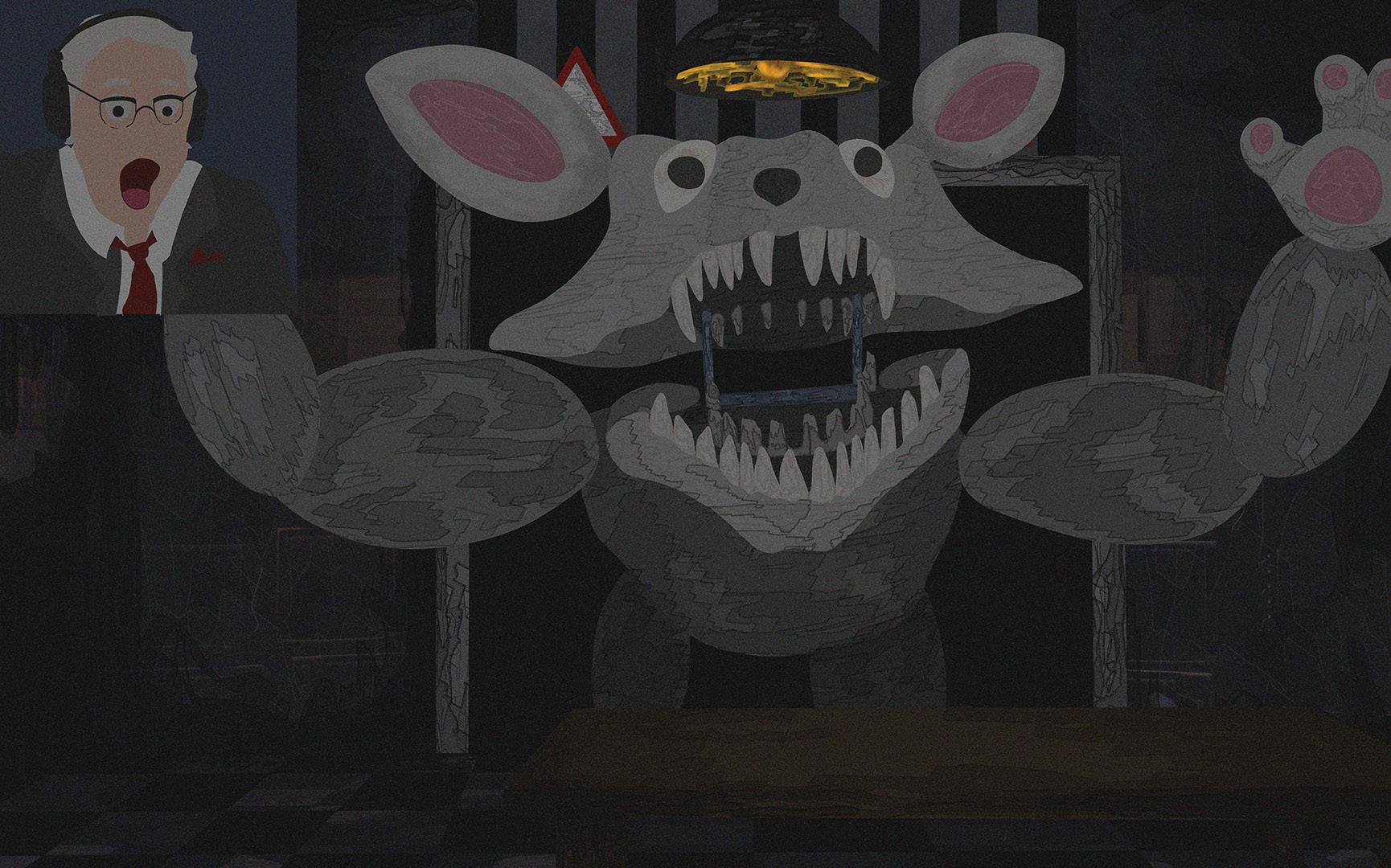
cided to touch up the robot with spray paint on the way to a game in Jacksonville.
“[Helms] was kind of overwhelmed by the fumes of the paint when he got in there and had to take the costume off,” Peeler said.
Hell made regular appearances at football games during the 1946 season, but was retired only a year later.
The exact cause of death remains somewhat of a mystery, but Wolford said she guesses it may have been a result of faulty mechanics.
“It was supposed to be able to operate on its own, and maybe after wearing it over time, it started to lose some of its mobility,” Wolford said.
In a train car bringing NC State fans back to Raleigh from the 1947 Gator Bowl, the Red Coat Bandsmen paid their respects in a formal funeral for the Wolf-monster. A somber photo of the service was featured on the front cover of The Technician along with a snarky comment about losing the game to the Oklahoma Sooners.
“I think that really invokes that kind of community, but also silly and irreverent aspect of NC State’s history,” Wolford said.
Since the Wolf-monster’s fifteen minutes of fame, NC State has yet to see another rendition of a robotic mascot. The closest attempt was made 50 years later by a group of students who created a robotic model of the iconic NC State Memorial Belltower.
“There was a belltower that students put together in the early 2000s … and it was kind of a robotics-automated kind of
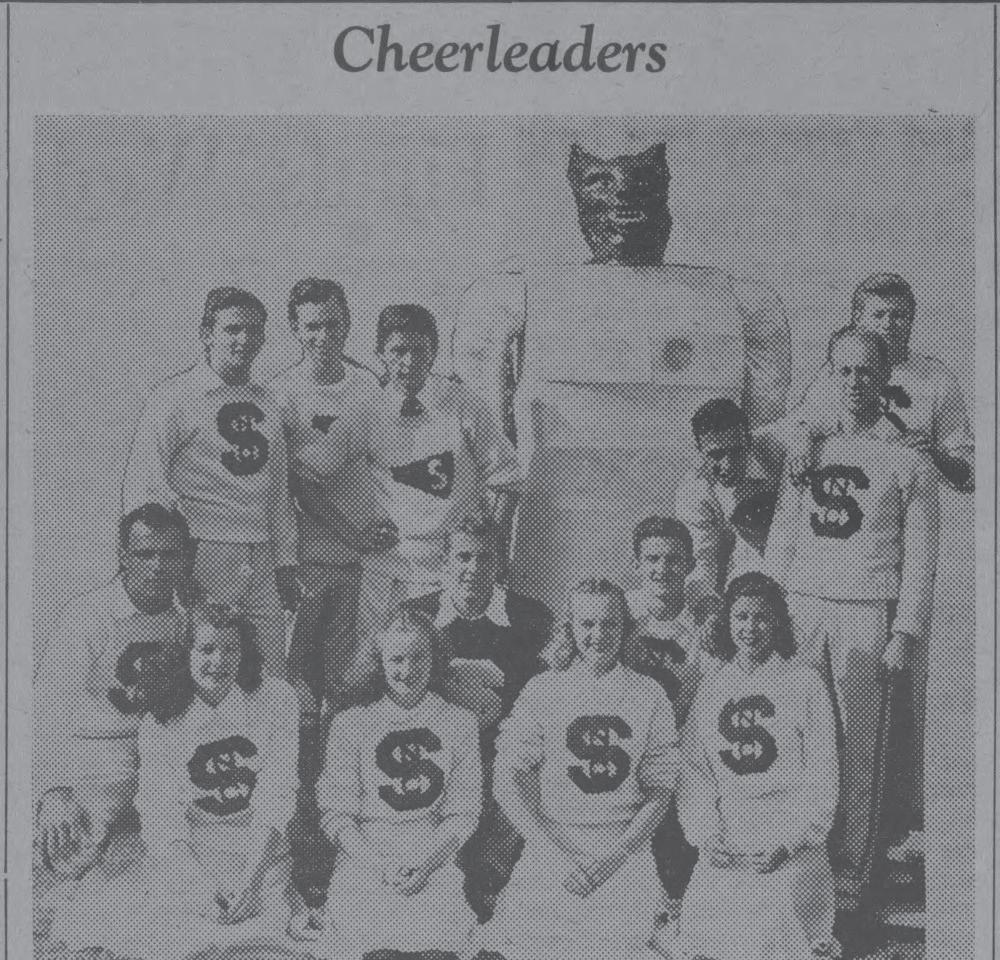
thing,” Peeler said.
While Hell may have been unconventional, its story offers a glimpse into NC State Pride. The University has a history of demonstrating school spirit, from live mascots to the beloved Mr. and Mrs. Wuf
we know today.
“It just is one of those experiential branding opportunities that the university has cultivated through the years to say, ‘This is who we are and what we are,’” Peeler said.
Dae Reed Correspondent
An archaeological excavation at Mordecai Historic Park is unearthing layers of rich history that have remained untouched for decades.
John Millhauser, an associate professor in the Department of Sociology and Anthropology, is leading the dig from Oct. 4 to Nov. 9, along with NC State students.
The Mordecai House, built by Joel Lane after American independence, is the oldest house in Raleigh still standing on its original foundation. It became the Mordecai House when Moses Mordecai married into the Lane family, eventually becoming the largest plantation in Wake County with up to 200 enslaved people at its peak.
The property remained in the family until the late 1960s when it was sold to Raleigh and developed as a historic park.
The current excavation was prompted by the discovery of old bricks by an electrical crew. The Office of State Archaeology determined the bricks dated back to the 19th century and could be the foundation of the original detached kitchen.
“Back in the day, having a detached kitchen was a kind of luxury, because it kept vermin and smoke out of your house,” Millhauser said. “It kept heat out of your house in the height of the summer, and it also reduced the risk of burning your house down.”
The Office of State Archeology contacted NC State, and have since been working in partnership to investigate the site.
Upon investigation, the team found evidence of cooking in the original site of the kitchen.
“There was animal bone coming up, things that would be left over from cooking,” Millhauser said.
Since its founding, the focus of the Mordecai Historic Park shifted from telling the story of the Mordecais and the surrounding historical neighborhood to the stories of the underrepresented.
“As the park has changed over the years in terms of its goals, they’ve turned towards telling more the 19th century story of all the people who were here, including the enslaved people,” Millhauser said.
Recent discoveries have allowed the narrative to shift towards stories that haven’t been told before — those of the enslaved
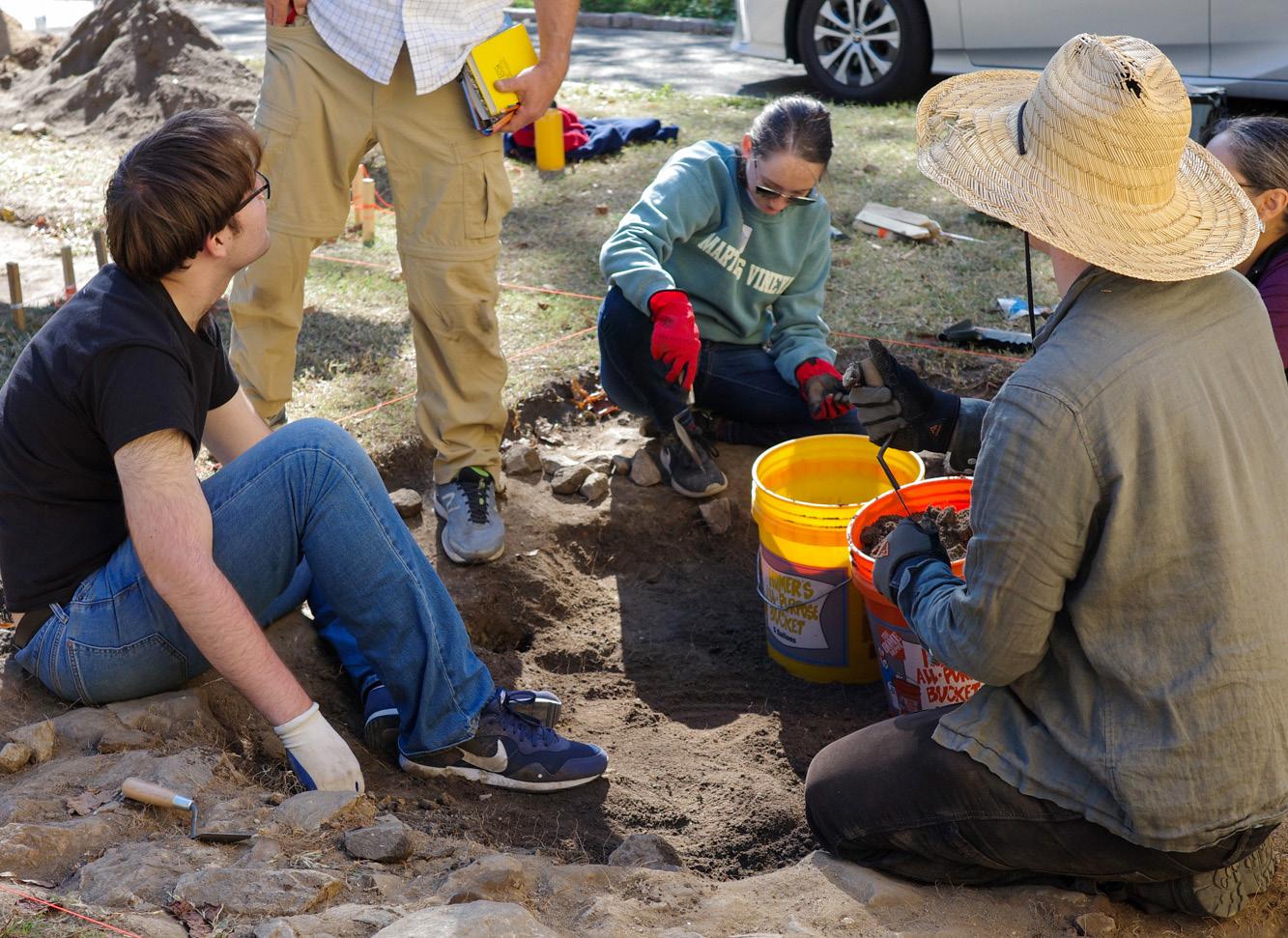
people kept on the property.
“We have window glass, we have nails, we have all kinds of construction debris, bones,” Millhauser said. “We have broken pottery and glass, things that you’d find in a home. Some of it is from last year, but this is an active park, and that’s part of the story. Some of it is from the 20th century when this was a neighborhood that was growing. And a lot of it is from the 19th century.”
Travis Corwin, a graduate student studying historic archeology, said his interest in the work stems from the curiosity that arises every time he uncovers something new.
“It’s just interesting to piece together that little puzzle piece of the past as you keep finding stuff,” Corwin said. “You encounter something that’s strange, and you just keep working around. Constantly things are making you question, and you have to figure out answers.”
An unexpected discovery was that of indigenous objects. The group uncovered an arrowhead that Millhauser estimated to be between 3,000 and 4,000 years old.
“People have been living here for thousands of years,” Millhauser said. “Multiple indigenous groups, the Catawba, the Lumbee, the Tuscarora.”
There’s always potential for unforeseen discovery in archeology, and Millhauser thinks that’s what makes it so important.
“Most people don’t get written about,” Millhauser said. “Most people, historically, couldn’t read or write either. Being able to investigate the material things that people made and used
and left behind opens up a far wider range of lived experience in the past.”
Since the beginning of the partnership between NC State and the park, investigations involving three different faculty and two classes in the past spring have been conducted. A class with professor DelWayne Bohnenstiehl in the Department of Marine, Earth and Atmospheric Sciences used applied geophysics techniques to do an initial assessment of what was under the ground.
The excavation itself started in May 2024. There were volunteers from the Department of Anthropology in the summer, and the current dig has upwards of 50 volunteers coming by from NC State and the city of Raleigh.
After the dig is complete, the materials collected will go back to the historical park’s lab. An NC State anthropology class about collections management will then use the materials to learn and apply techniques of curation and cataloging. From there, Millhauser said that, ultimately, the fate of the artifacts is the park’s choice.
“They’ll take the lead in how they choose to share them and use them to tell the stories of all the different people who lived here.”
The Mordecai Historic Park is in contact with descendant communities of those who worked at the house, and now different tribal organizations in the Triangle, making sure their interests are well-represented.
Charity Sullivan, a graduate student studying anthropology who was volunteering at the dig, said this kind of work is important for telling stories that are historically underrepresented.
“It gives them a chance to learn their history as well,” Sullivan said.
Millhauser agreed that learning the whole story, not just fragments, is important to people today.
“I believe that there are merits in trying to learn about as many different people in the past as we can, to understand all the ways that they work,” Millhauser said. “Whether that story is the presence of indigenous people here, and potentially the continuing importance of this place to indigenous people, or the lives of enslaved people, or all the different people whose lives are intersected here. I believe there’s value in that, and in doing it well.”
Matthew Junkroski Staff Writer
Ants, spiders and cockroaches might be nuisances to most people, but for Adrian Smith, head of the Evolutionary Biology and Behavior Research Lab at the North Carolina Museum of Natural Sciences, zooming in on these miniature marvels to reveal the magic of insects is the premise of his YouTube channel, AntLab.
AntLab wasn’t always this way. Though Smith always had an interest in media, he said his experience with film began in college.
“When I was a graduate student, I secretly
enrolled in a community college film school at night, first semester and learned how to edit,” Smith said. “And then I quit and just started learning on my own.”
Smith said AntLab began as a way to display his research to colleagues but evolved to display insects to the general public as well.
“I didn’t really know why to make a video beyond sharing a research story when I first started making them, and then I figured out different reasons for making a video,” Smith said. “So then it was just about filming stuff from the perspective of someone who’s a professional entomologist with a lab with all this equipment.”
Initially, Smith worked with ants, which was something he said he stumbled upon during his undergraduate experience. Although his first experience with ants wasn’t what he hoped for, he learned to find them fascinating.
“You can have a shoebox-sized [container] that’s a colony of thousands of individuals cooperating and doing a bunch of social-collective tasks together, which is really interesting to study,” Smith said. “I was fascinated once I learned you could ask questions about how insects behave, but you could also ask questions about how like societies are organized and function in the animal world.”

Jordan Birkner Correspondent
Where can one find a pirate, a mouse, a clown and Spongebob Squarepants around one table?
These and more innovative costumes were created by NC State students at the “Spooky Stitches” event held on Oct. 24. The hosting organization, the Sustainability Stewards, are a group of NC State students who drive environmental changes on campus. Throughout the year, over 250 sustainability events are hosted on NC State’s campus, many led by the stewards.
Evie Dallmann, a third-year studying biology, is head of the Stewards’ equity and outreach branch and the planner behind the event. “Spooky Stitches” was inspired by a workshop included in the 2024 Environmental Justice Symposium which focused on mending to maintain clothes and limit textile waste. Materials for this event were donated from the Campus Thrift Store and The Scrap Exchange in Durham.
“I feel like there’s a lot of waste during Halloween, but also a lot of potential to make something, which I feel like is what Halloween used to be, you made your costume,” Dallmann said. “It was cool, it was yours. If you show people how to sew and how to mend, they might be more inspired to get creative or just maintain their clothes.”
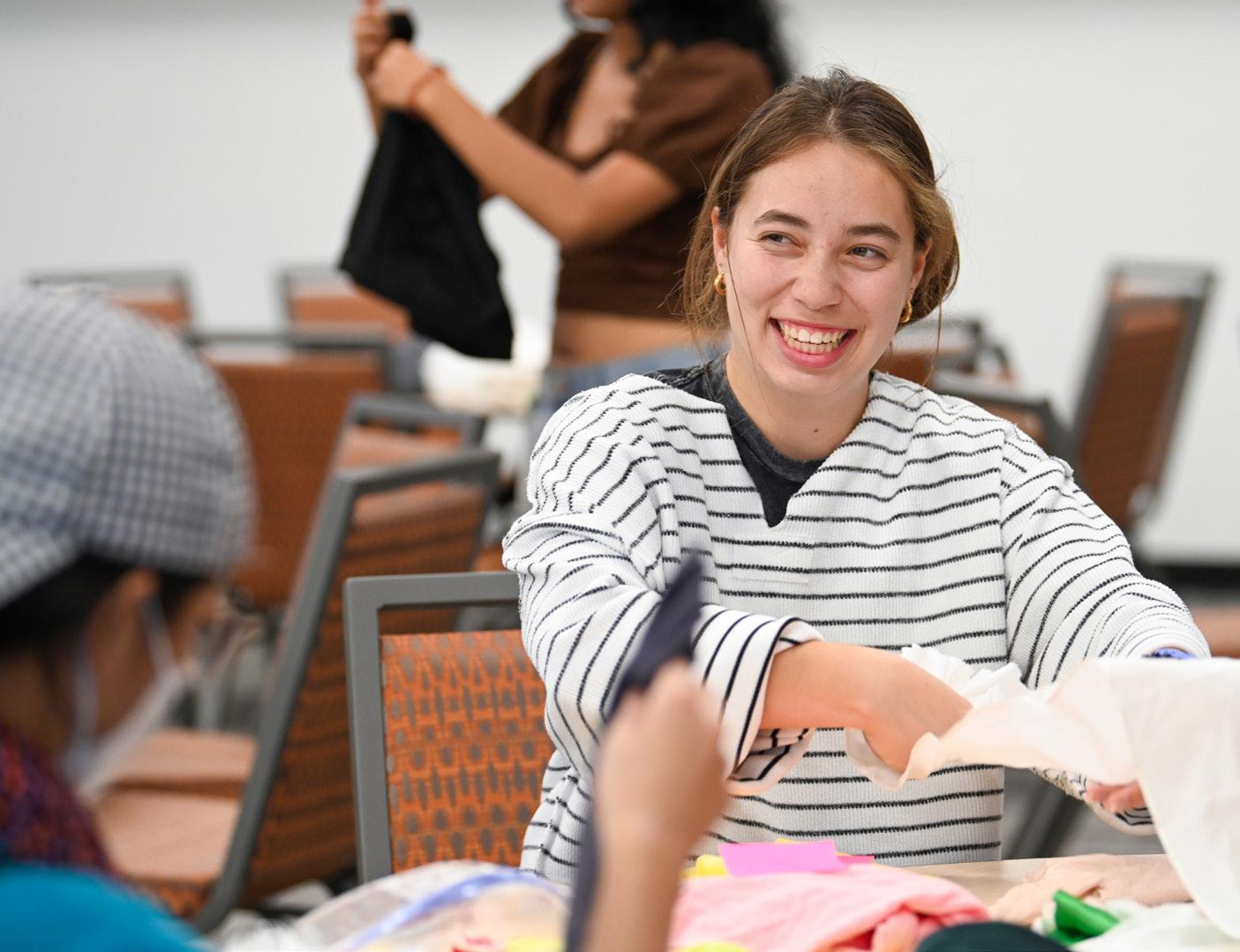
This enthusiasm was shared by other equity and outreach members of the Stewards at the event. Brooke Hartman, a third-year studying environmental science and natural resources, expressed being pleased to see an original idea like Spooky Stitches come to fruition.
“I think it’s so cool that we get to find a way to make Halloween sustainable because it’s one of the most over-consumed holidays ever,” Hartman said.
Jada Stewart, a first-year studying engineering, attended the event after passing Witherspoon Student Center, where Spooky
Stitches was held. She plans to use the pirate costume she created at the event.
“I saw the sign and was like, ‘I need a Halloween costume,’” Stewart said.
Those who made costumes at Spooky Stitches will have an opportunity to display their creations at this year’s Environmental Justice Symposium. This event is hosted by the Stewards each spring to develop sustainable skills and investigate topics impacting the environment. Dallmann and Hartman hope to see costumes from Spooky Stitches in the symposium’s art showcase.
The Stewards will continue upcycling efforts after the holiday. They are organizing a mini-market with sustainable creators on Nov. 6 and a Halloween Waste Drive on Nov. 8. More details about these events can be found on the Stewards’ social media and website.
Our community can learn from the sustainable practices seen in Spooky Stitches with costumes and fast-fashion moving forward.
“There’s hyper saturation of anything you’re going to get online,” Dallmann said. “The sourcing of the materials, if not the materials themselves, are environmentally degrading. … A lot of them are nylon or plastic itself, and wearing that plastic isn’t good for your body. … So we challenge people to be a little bit more creative and thoughtful about the environment beyond these few days that are very fun.”
Alessandra Sandoni Correspondent
Taking a semester abroad is the perfect occasion to practice a language, learn about another culture and experience a new country just like the locals. What’s a better place to immerse yourself into the tradition of American food and entertainment than the state fair?
Not only was the whole fair so much bigger than expected, but the list of food options was endless. It would have been impossible to try everything in just one night.
The wonderland of deep-fried food, the state fair rule is seemingly anything that is edible can also be deep fried. An onion? Sure. Snickers bar? Of course. There is no limit to what these food trucks can accomplish with a few gallons of burning oil.
Pairing is another culinary rule that doesn’t exist on state fair soil. While Italian cuisine is strict about what goes with what, the state fair cooks are kitchen daredevils to whom rules don’t apply.
I started my culinary experience with a churro dog: a classic hot-dog sausage covered in unsweetened churro dough, covered with melted cheese, ketchup and bacon bits.

Kelsey Bohn Correspondent
Fashion comes and goes, but the most haunting trends would need an exorcism to be removed from my mind.
The fashion industry is fast-paced and always facing pressure to develop the newest phenomenon. With a quick turnover, mistakes are unavoidable and difficult to avoid.
Sometimes, these missteps in the fashion framework still manage to catch on, and we are left with haunting memories like a framed graduation photo with 2016 waytoo-thick eyebrows immortalized on your grandma’s mantle.
This fall has been no exception to the blips of nonsense coming from the runway. We’re only a month into the season, and there is more than enough to keep my nightmares fueled.
What first comes to mind is the 2024 Victoria’s Secret Fashion Show. After a six-year hiatus, the brand announced that its widely popular fashion show would return in October 2024. This drummed up a lot of buzz and turned it into arguably one of the most anticipated fashion moments of the year. High hopes surrounded the brand’s reemergence into the spotlight — people expressed their hopes and dreams for the event, and the live stream brought in a lot of viewers.
There was no shortage of talent at the show, with models such as Bella and Gigi Hadid, Adriana Lima, Alex Consani and Ashley Graham. However, some of the artistic choices fell noticeably short.
Slick-back ponytails have been a staple hairstyle for 2024 — great for an everyday look and can be dressed up for a fancy occasion. However, when Victoria’s Secret changed their signature bombshell, blownout curls to a more muted slick back, it caused a major divide amongst long-time fans, who wished they had stuck to what they know works best.
As part of another attempt to modernize, many of the normally intricate, feathered and fantastical angel wings worn by the models were reduced to plastic, shiny weaved patterns that felt more like shrunken PVC pipes
continued from page 6
It was a great start and everything a foreigner would expect from American food. Deep fried Oreos are a state fair staple I had to try — and they were actually pretty good. They tasted like mini donuts with a smidge of Oreo flavor drowning in fried dough. Of course, no American dessert can stand the fight against Italian tiramisù.
In my limited knowledge, I thought popcorn had very finite variants, and that chocolate and

instead of head-turning masterpieces.
The 2024 Victoria’s Secret Fashion show pointed to a larger trend within the fashion industry: minimalism. The intricacy of fashion is on a steep decline, with runway looks sticking to solid colors and sleek designs.
The denim-on-denim trend debuted on the runways of popular brands Fendi, Schiaparelli and Rokh to inspire 2024 fall fashion. The trend consists of wearing an outfit consisting only of denim pieces.
While it’s not impossible to get creative with your fully-jean outfit, it does point to the overall trend of uniformity in fashion.
If we go back in time, such as to the Victorian era, clothes were significantly more intricate, but of course that was at the cost of being less functional. While it’s unreasonable to demand that we bring back corsets and ball gowns, it would be nice to see the same level of creativity and craftsmanship incorporated into the functionality of mod-
caramel were two of the most extravagant options. Oh was I wrong. I was introduced to kettle corn and the many flavors they come in. Jalapeño kettle corn took me less than a couple of seconds to start coughing and regretting my decision. It felt like having a spoonful of jalapeño powder and I could barely taste the corn. I wouldn’t recommend it.
When it comes to drinks, I’m conservative in my soda choices and always go for the classics. But when I heard that Cheerwine was a drink native to North Carolina, I had to try it. I was happy to only have gotten a sip and not a full can. Just like Dr. Pepper, it’s too sweet for
ern clothing.
Comparing Victorian fashion, architecture or even handwriting to modern aesthetics is always a fascinating lens into how modernization has become synonymous with reducing uniqueness and intricacy.
The “coquette” trend revived inspiration from the Victorian era. Coquette fashion features feminine silhouettes, pastel colors and lots of dainty pink bows.
The coquette aesthetic has trickled in and out of popularity starting in the 1990s and has continued to be revived by pop culture moments like the 2020 release of the show “Bridgerton.”
In 2023, the trend flew to the front pages of fashion magazines. “Coquette aesthetic” amassed over 1.5 billion views on TikTok, and bows flew to the shelves of every major fashion brand.
Unfortunately, the commercialization of coquette also meant the removal of much
my Coke Zero taste buds. Cherries should just stay fruit and not be turned into carbonated beverages.
Then it was time for more dessert and red velvet funnel cake was a whole experience. I had heard of funnel cake before and I love anything red velvet, so it seemed like a match made in heaven. Made for bigger stomachs than mine, it was so much that I had to share it and ended up struggling to finish my quarter. The red velvet flavor was good for the first couple of bites, but became boring and way too sugary half-way through. Deep fried Oreos definitely won my Best State Fair dessert award.
of the creativity that followed behind the trend. Brands like Urban Outfitters began producing clothing lines with bows jammed into every seam.
A year later, we have yet to see any real ingenuity from the major corporations that have taken over mass production of the coquette trend. Instead of continuing to build on Victorian inspiration, they have stopped at the bare minimum, expecting us to see a black sweater with a bow on it and call it a return of the Renaissance.
Fashion is a form of personal and artistic expression, but it’s also very dependent on functionality. Clothes that aren’t wearable won’t be worn.
However, functionality and minimalism are not synonymous. It is up to fashion designers to continue finding ways to create clothing that is both practical and demonstrates artistic ingenuity.
Milk and cookies was the ideal combination to bring the evening to an end, with the perk of getting a cute bucket to transport them back home. They were warm and soft, and even though I prefer the crunchy version, nothing like a staple of American cuisine can better bring the circle to a close.
Luckily, no stomach ache hit me after the unhealthiest meal of my life. And while American food is not my favorite and I’m nostalgic for home, the North Carolina State Fair culinary experience was definitely one worth trying. North Carolinians know how to have fun.

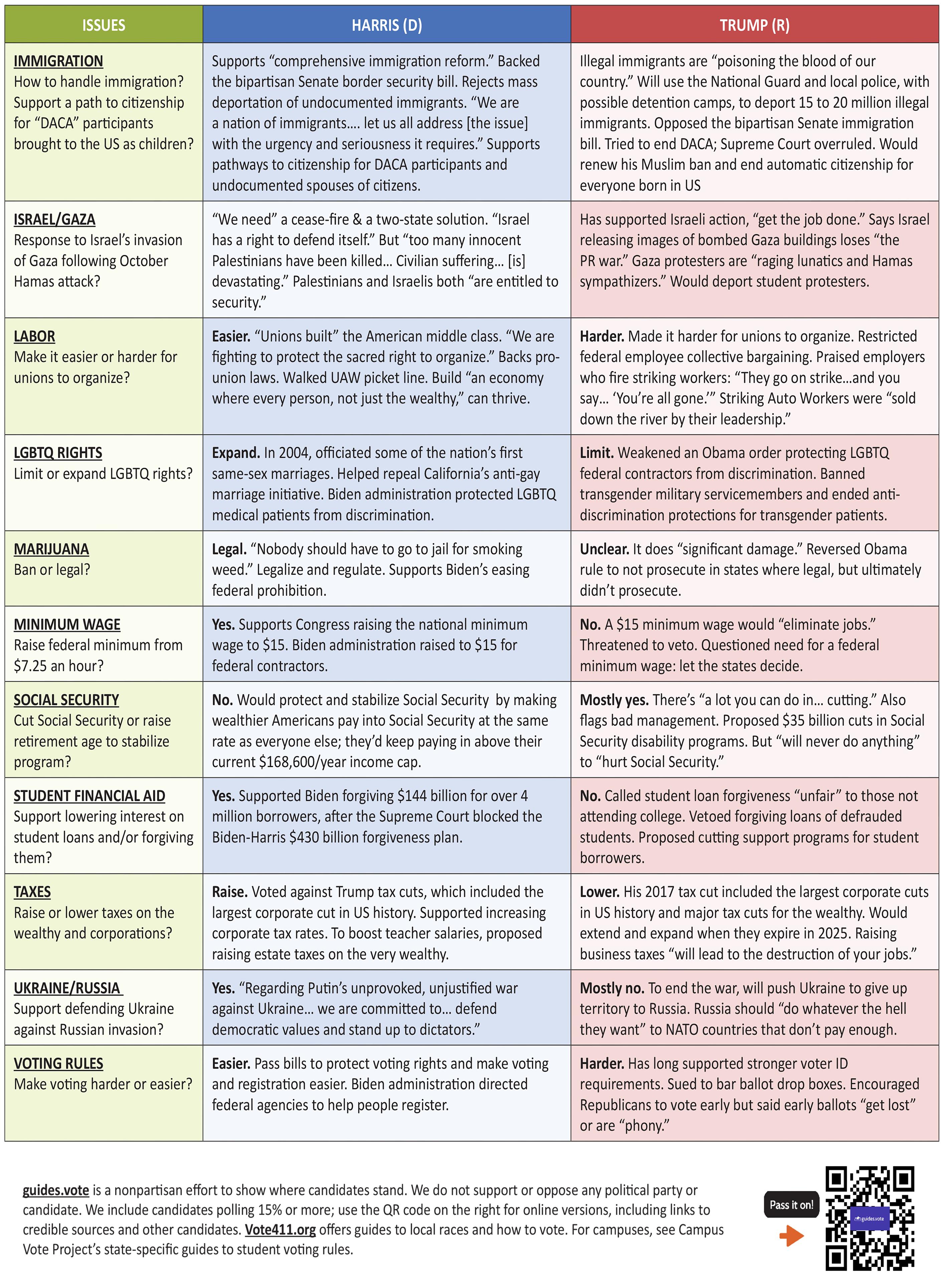


Dressing as Flynn Rider and Rapunzel or Monica and Chandler for Halloween just isn’t cutting it anymore — these classic costumes are overrated. Couples need to get creative and think outside the box. In the following sections, you, dear reader, will find several underground couples’ costumes that will also make your friends jealous.
Nothing says “Go Pack!” like navigating the obstacle course of construction and hazards on your way to class. Who needs a straight shot to your 8:30 a.m., when you could be working on your stamina on the way there?
You’re already shelling out thousands to be here, so why not give back by grabbing a hard hat and diving into this endless loop of breaking down the campus and building it back up? Tuffy may huff and puff and blow our brick houses down, but doesn’t it warm your heart to know that we’ll always be here,

picking up the pieces brick by brick?
Just as the Wolfpack seems to have an unhealthy attachment to constant renovation, you can show your constant dedication to “fixing” your situationship this Halloween in this couples’ costume. No matter how many bricks we tear down and rebuild, we’ll still be dodging potholes and red flags by the spring.
A football player and a Butterfinger bar
We love you NC State football, and this costume is entirely unrelated to the fact that the band is the best part of our gameday. Or the fact that we haven’t won 10 games in a
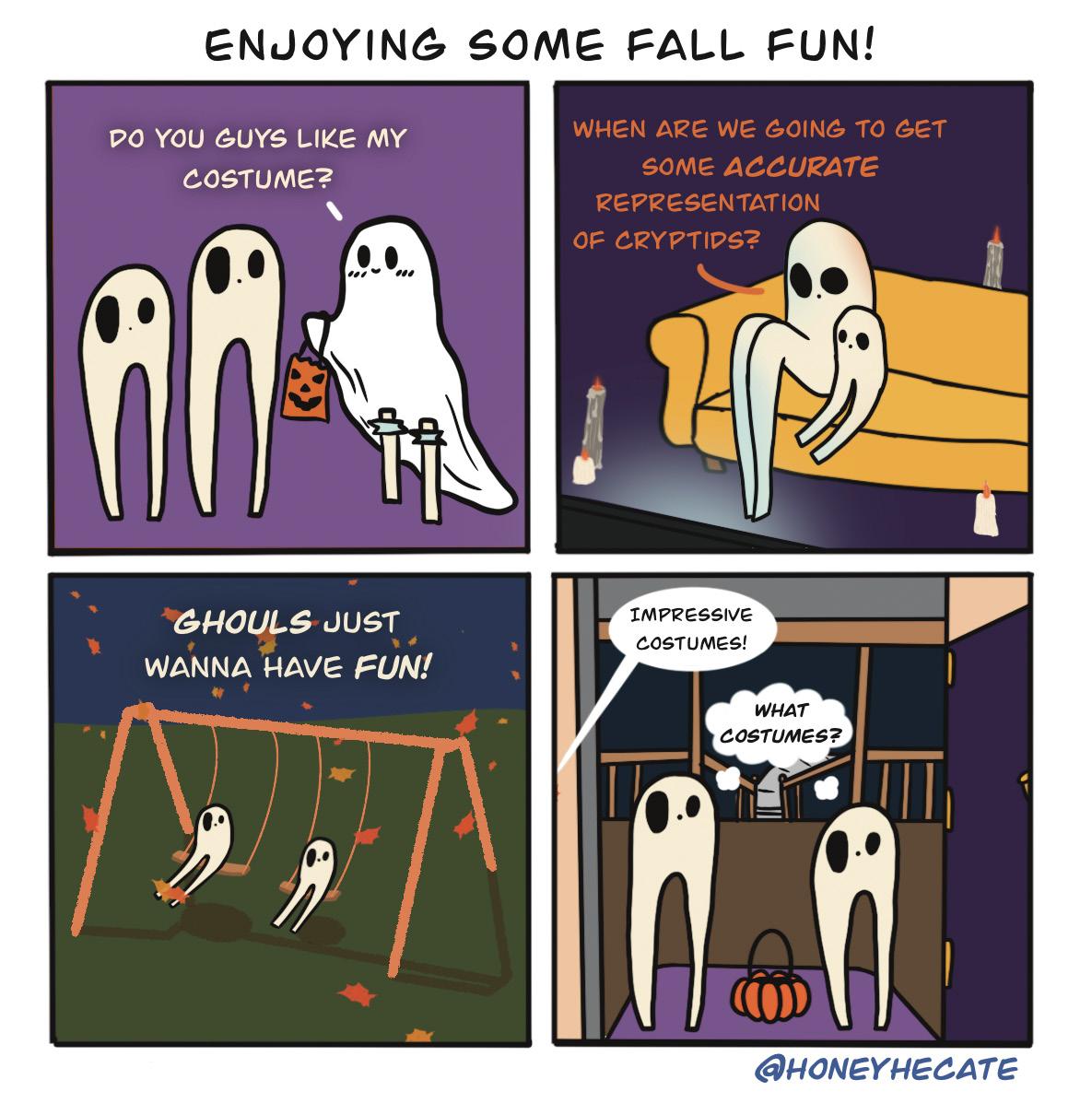
season since 2002. Or the fact that the team managed 15 fumbles so far this season and lost nine. We promise.
While our relationship with football might be toxic, your love affair hopefully isn’t. So suit up, and let it serve as a tribute to your relationship’s resilience and your readiness for whatever curveball — or fumble — comes your way.
Remember: Even if it looks like your relationship is about to head straight into overtime, there’s always a stressful game to take your mind off of it. If it’s not one thing disappointing you, it’s another, win or lose.
On the bright side, for some of you, being busy yelling at your TV means you don’t have time to focus on the fact that your re-
lationship is falling apart. We know you’ll never stop watching, even when you say you give up. Just like you’ll never put that relationship out of its misery.
Of course, we didn’t forget about the hottest topic on campus. As a tribute, everyone should know how thrilled you are to have sat in those classrooms for several years. Breathing plain oxygen is clearly not something Generation Z likes to do anyway.
And for all the couples out there who might relate a little too well to this toxic, occasionally suffocating energy — yeah, we see you.
Embrace your love-hate relationship with this campus classic. Because, just like your situationship, some things are just destined to keep you hot and bothered.
As NC State students, we have so many great options to choose from. Whether you’ve been here through the struggles of our football team or started amidst the rubble of the Brickyard, there’s something for everyone.
So, there you have it — some of the best couples’ costumes for you and your boo to match this Halloweekend. Sure, you’ll probably look back at pictures of these one day and cringe, but isn’t that the beauty of it? After all, nothing says “‘til death do us part” like a wolf and a construction worker. So go forth, make memories and may your couples’ costumes be only mildly regrettable — but not as regrettable as the way you’ll feel the next day.
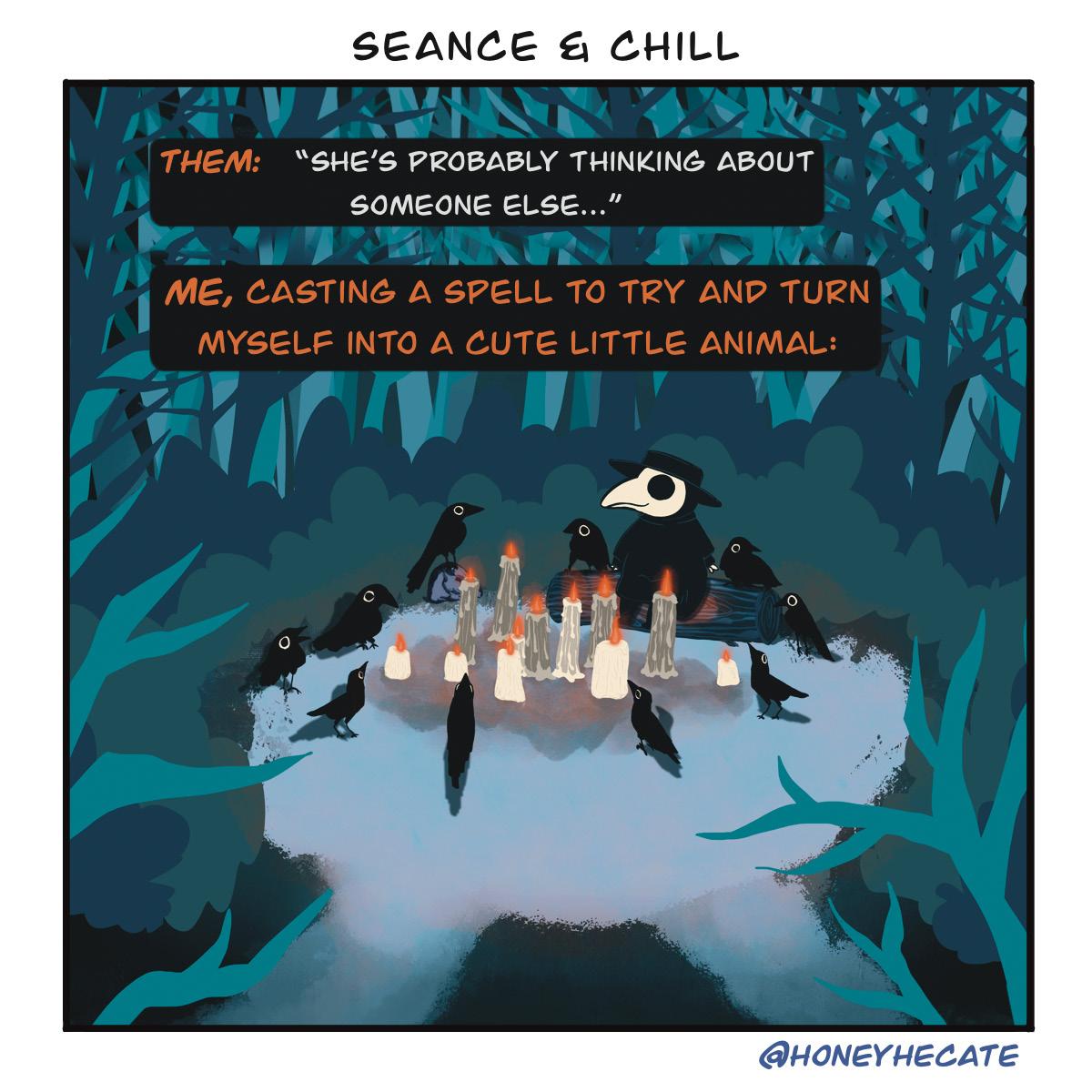

Jack Bissette Correspondent
Editor’s Note: This article contains reference to blood, gore, violence and death.
The slasher is a universal symbol. We all know Michael Myers, Freddy Krueger, Jason Voorhees, Leatherface, Pinhead and so on. It’s been a while since we’ve had a character like these apart from their ill-fated and illadvised reboots, remakes and prequels that hardcore fans tend to scoff at.
The modern slasher movie has been in a bit of limbo, but as we have seen in recent news with Damien Leone’s “Terrifier” film series, we might be in for a bit of a renaissance — a rebirth of our roots.
I watched Terrifier 3 just a few weeks ago, and the theater was packed. What followed was two hours of the most vile, nauseating gore I’ve ever had the (dis)pleasure of sitting through in a movie theater. I’ve seen hundreds of horror movies, but none have turned my stomach quite like Terrifier 3. Despite, or perhaps because of, its gruesome content, the film is slated to defy box office predictions and reel in an impressive $50 million, while reporting just a $2 million budget.
One thing that stuck out to me wasn’t just
the horrific violence on screen but the audience at my screening. I got there early and watched as fans walked in wearing “Nightmare on Elm Street” T-shirts, donning hats embroidered with Jason’s mask and chatting about how much they loved the last movie and couldn’t wait to see what “Terrifier” focus Art the Clown would get up to next.
What stands out to me is how characters like Freddy Krueger and Jason Voorhees are decades old, yet their iconography certainly persists. But what is it about the slasher specifically that leads to this kind of reverence?
I think they live on because they’re really not as simple as one would think.
I’m not going to sit here and pretend these are the deepest movies on the planet or even the deepest horror movies. However, the slasher film is what the horror genre evolved into, essentially starting with Hitchcock’s revolutionary chiller “Psycho” in 1960 and dominating the horror landscape from the mid-1970s onward. From that point on, these films consolidated evil and violence into one entity, establishing genre tropes that would persist for years.
However, this subgenre is not as simple as masked killers wielding chainsaws or machetes and chasing around cheerleaders.
Beyond their hacking and slashing, these iconic on-screen killers can be rich with subtext and symbolism. Michael Myers can be read as a metaphor for the breakdown
of the nuclear family and the violence that underlies suburban American life.
Leatherface, in my personal favorite slasher “The Texas Chainsaw Massacre,” could be taken to represent the brutal, dehumanizing nature of industrialization, as evidenced by his gas-powered chainsaw tearing through his victims.
Ghostface, from the phenomenal “Scream” franchise, could represent how the sensationalization of violence in media blurs the lines between reality and fiction.
It is clear these films are not one-note, however they are all operating within the same horror space. They use the bones of the slasher subgenre, its symbols and tropes, to tell different stories that offer serious insight into issues of their times, issues that are as vital as they are diverse.
The thing that is so powerful about horror, a quality not really shared by any other genre, is that it is in constant conversation with itself.
Even in “Terrifier 3,” one can spot homages to “Halloween” and “The Evil Dead,” and the film even features a small cameo from horror legend Tom Savini, the SFX pioneer behind such classics as “Dawn of the Dead” and “Friday the 13th.”
These aren’t just chances for the audience to point at the screen and feel a brief satisfaction for getting the references; they are working through and alongside the geneal-
ogy of blood and guts that has made up this puzzling and mortifying subgenre.
That brings us to the horror of the modern era and the “Terrifier” film series, which might be a bit different from these aforementioned classics.
The period of modern horror has given us fantastic films like “The Witch” in 2015 and “Hereditary” in 2018. We all know the type, with its eerie music and long, suspenseful takes, where the real horror is what we don’t know or can’t see, rather than some crazed killer in a hockey mask. Don’t get me wrong, I adore these films, I just view them as a different set of methods within the horror genre that attempt to achieve similar goals.
“Terrifier 3” might not be tackling the most complex themes in the world, or doing so with the utmost grace and artfulness of the greats, but does it really have to?
Maybe people are getting tired of these cerebral slow-burns that have begun to color the horror landscape. Sometimes people just want to see some cheesy acting, excessive violence and a whole lot of blood. Sometimes audiences like to see a clown hack and slash through his victims in over-the-top, unbelievable ways. Is that healthy? I’m not sure.
Is it fun? I would say so.

Abbigail GoetzeThompson Correspondent
Editor’s Note: This is a work of satire. It should not be taken seriously or applied literally.
Decorating for the holidays is part of what makes them so special and fun.
It’s important to note that you can truly save so much time and money by ethically and naturally sourcing your Halloween decor. Since consumerism has taken over and people are much more materialistic than they used to be, I cannot underestimate the charm your living space will carry once you abuse free will and let your imagination run free. One of my favorite tactics is not cleaning my room. This is great because it kills two birds with one stone.
Not only do spiderwebs start forming in every corner and crevice that goes untouched for too long, but little creepy crawlies find their way into my room too.
It’s a real game of roulette to see which critters will venture into the pile of clothes on my floor or the molded cups on my desk.
Sometimes it’s a cockroach or another harmless bug. But, if I’m lucky, I’ll discover a rat.
As effortless as that is, pumpkins truly have to be the easiest decoration of them all. You can grow these pretty much anywhere. You don’t even need a yard. All it takes is a patch of grass and some love.
Everyone has a park near them, or a field of some sort. With enough love, care and water, you’ll get a pumpkin in a few months max. Bonus points if it grows in some strange, misshapen way. And we don’t have to be picky about pumpkin types; gourds are welcome too. I’m always saying: the more warts, the better. As long as you are willing to do some Halloween preparation, these will serve as beautiful jack-o-lanterns when the right time rolls around.
This technique is much more satisfactory too. You get to see your own hard-earned work instead of buying some overpriced
fruit from the grocery store.
Next, as a big Halloween fan myself, I love some candy corn. It’s totally underrated, and I go through a few bags of it a year. I am far too tempted when stores start putting it on the shelf as early as June.
But every time I tell somebody I enjoy this sweet treat, they harass me about the amount of sugar in these little corn pieces.
Recently, I’ve decided to listen to the constructive criticism I’ve been receiving and have started to buy corn in bulk — just right on the cob. I’ve found that when you shell it and roll the pieces around in some syrup, you can almost imagine you are eating the same thing.
Another issue of mine is that when it comes to creative liberty, I don’t think we utilize the power we hold like we should. The whole witches and ghosts and skeleton thing is getting pretty old. We see this sort of thing every year. Does nobody get tired of seeing the same decorations over and over again?
I propose we introduce something far
more terrifying, something that lots of people are afraid of.
Maybe it’s admitting you were wrong, or having to take a test you didn’t study for. Or, my personal favorite, public speaking. For the latter, the decor can be simple; all you need is a stage, a fabricated audience and a mic or a powerpoint presentation. You don’t even need friends for this one, as stuffed animals or skeletons, if you insist on using them, would do just fine, but brownie points to those who know enough people to pull this off.
Hayrides and corn mazes are nothing compared to the true fear you will feel while putting your ego on the line.
These are just a few ideas that have been brewing in my head for a while now, but I encourage anybody who is reading this to come up with some ideas of their own. I’d love to start seeing some new and original Halloween scenery.
Raleigh voters ought to reckon with the ‘T.RUTH’

Justin Welch Managing Editor
Just over two years ago, I sat down for my first-ever interview as a correspondent at this publication. A columnist by trade and fresh-faced college underclassmen in life, I didn’t have a lick of confidence in my ability to orchestrate such a meeting.
Ruth’s campaign has a genuine ethos. Cowell only has her name and pocket full of real estate money.
Somehow, my editors allowed my first at-bat to be a Raleigh mayoral candidate.
Terrance Ruth, an instructor at NC State with extensive community and non-profit experience, graciously and enthusiastically took up my invitation. A few election cycles later, a few more years under my belt as a reporter sprinkled in with some city government experience, and Raleigh again faces the question of who should lead our city.
And once more, voters are faced with a clear choice of progress that departs from convention and an established middle-of-the-road politician. For the sake of our city and those who most need its support, voters should choose the T.RUTH. American politics have become an apathetic game. Though many are quick to shame those who abstain from the political process, I can’t ever fault those who don’t believe in the system. Anyone truly tuned in knows that we’ve got problems.
What makes anyone believe in a system that seems to be constantly falling apart at the seams?
I remember leaving my interview with Ruth with a single takeaway in my head: This man is the brand of politics I can believe in. He is — though possibly the cheesiest line I’ve ever put in writing — the truth.
The term “politician” has become synonymous with all the trivialities and corruptible susceptibilities mentioned above. Ruth in no shape or form embodies the characteristics of the modern “politician.”
Ruth, first and foremost, is a social worker. He has been a lecturer in NC State’s School of Social Work for almost eight years — ask any of your classmates in the program and you’ll get a glowing testimony. Before giving lectures, Ruth conducted state policy research with the University’s Friday Institute for Educational Innovation.
His community involvement outside of the classroom demonstrates his versatility in delivering public service. Ruth served as the executive director of the North Carolina chapter of the NAACP and has been a senior leader in several
non-profit organizations focused on equity and social justice.
Though Ruth’s background is perhaps not conventional to politics, it’s that very reason that makes him the best candidate. Ruth has built a career solely on the premise of helping people and seeking to understand the societal conditions that give rise to our community’s biggest issues.
Though Cowell has a very respectable background, she doesn’t remotely constitute anything close to a change for our city. Her actual platform removed from her past is incredibly uninspiring. Contrast the candidate’s responses to questions about the city’s most important issue, affordable housing. Cowell’s answers are generic. Ruth writes a book.
Ruth wants to immediately implement measures to support renters and those most disadvantaged by the current state of the housing system. How practical are these changes and the timeline he lays with them? I’m not sure he could implement them the day he walks in the office on Hargett Street, but at the very least the initiative to do something holistic and urgent is the starting point we are in desperate need of.
What I am sure of is how much money Cowell has raked in from developers. Her tens of thousands accrued solely by property-affiliated donors far exceed Ruth’s total contributions. Her campaign finance disclosures may as well just be a list of the top grossing real estate agencies in the greater Raleigh area.
When you talk to Ruth, you begin to understand politics as less of a game and more of a calling. It has nothing to do with advancement or ego; it’s about helping people and dealing in empathy. It’s hopeful and grounded in finding real solutions, and it’s what the idea of governing should actually feel like.
Though Cowell has all the experience in the world, I similarly am unsure of what her vision entails. How local media, political parties and personalities have coalesced behind her name recognition, I don’t know.
My best guess is continuity. Ruth and the other candidates on the ballot believe a genuine reckoning is necessary to address the issues. For the affluent and well-off demographics of Raleigh, more of the same probably sounds ideal. Allocating resources and attention to the housing crisis may not be in the best interest of those residing in historic Oakwood.
If Raleigh voters believe we need change and reflect on the truth of the matter, they should choose Terrance Ruth for mayor.


Matthew Burkhart News Editor
As Raleigh prepares to elect a new mayor for the first time since 2019, the city faces critical challenges, including rapid growth and affordable housing. While both frontrunners Janet Cowell and Terrance Ruth bring valuable perspectives to the race, Cowell’s extensive background in public service and pragmatic approach to policymaking make her the superior choice to lead North Carolina’s capital city.
Janet Cowell’s extensive experience, familiarity with city stakeholders and sustainable approach to development will ensure Raleigh has a mayor who hits the ground running.
It’s no secret that experienced leadership is essential to navigate these complex issues effectively amid an election that could turn the city’s government on its head.
Cowell’s resume speaks for itself. She previously served on the Raleigh City Council, represented the city in the North Carolina Senate and completed two terms as State Treasurer. This wealth of experience at multiple levels of government gives her unparalleled insight into the intricacies of municipal governance and state-level policymaking. As the former president and CEO of the Dix Park Conservancy, she also brings a deep understanding of one of Raleigh’s most ambitious urban development projects.
In contrast, Ruth, while a respected professor at NC State, lacks direct experience in city government. Though he launched an impressive challenge to unseat incumbent Mayor Mary-Ann Baldwin in 2022, his platform remains more aspirational than practical.
Cowell’s pragmatic approach to Raleigh’s challenges is evident in her stance on affordable housing. She acknowledges the need for denser development but combines this with a commitment to environmental preservation. Her proposal to explore tax increment financing demonstrates innovative thinking about funding mechanisms for affordable housing initiatives.
Ruth’s housing platform, while well-intentioned, lacks the same level of specificity. And though he has valid critiques of the city’s communication around zoning reforms does not offer concrete solutions to the underlying affordability crisis.
In the wake of Hurricane Helene, climate resiliency has become a pressing concern for all of North Carolina. Cowell’s experience as State Treasurer gives her a unique perspective on the
financial implications of climate change for municipal governments. Her emphasis on preserving Raleigh’s tree canopy and investing in the city’s creek and greenway system shows her dedication to using green infrastructure to mitigate flood risks and improve urban climate resilience.
Both candidates recognize the challenges facing Raleigh’s police force, particularly around recruitment and retention. Cowell’s approach, however, is more comprehensive. She acknowledges the recent pay increases for public safety officers but also recognizes the need for ongoing adjustments based on forthcoming studies. Her support for programs that divert non-criminal calls away from police demonstrates a nuanced understanding of modern public safety needs. While Ruth has made community engagement a centerpiece of his campaign, Cowell’s approach is more realistic and technologically forwardthinking. She proposes leveraging technology to create an accessible, more two-way communication between city government and citizens, acknowledging the limitations of traditional public meetings. This approach could lead to more inclusive and representative community input.
On top of all of these points, Cowell’s is backed by a strong roster of endorsements. She has garnered support from major local publications like the News & Observer and Indy Week, as well as influential organizations such as the Wake County Democratic Party, Equality NC and Capital City Fire Fighters. These endorsements lend credibility to her vision and demonstrate broad-based support across various sectors of the community. In contrast, Ruth’s campaign website lacks information on his policy priorities and does not list any endorsements, potentially indicating a less robust campaign infrastructure or weaker community backing, along with a general lack of care for communicating his policy in exchange for simple, brooding web design.
Cowell’s combination of extensive government experience, pragmatic policy approaches and innovative thinking make her the ideal candidate to lead Raleigh through its next chapter. While Ruth offers a fresh perspective and admirable commitment to community engagement, Raleigh’s complex challenges require a leader with proven experience in navigating government bureaucracies and implementing effective policies.
As Raleigh continues to grow and evolve, it needs a mayor who can hit the ground running. Janet Cowell’s track record and comprehensive platform demonstrate that she is best equipped to lead Raleigh into a prosperous and sustainable future.

Colby
Trotter Sports Editor
When Robin Simonton was hired as the Executive Director of Historic Oakwood Cemetery in November of 2011, she was unprepared for what would come four months later. Simonton knew about the rich history of NC State men’s basketball but was also familiar with its struggle to keep up with UNC-Chapel Hill and Duke for the last 30 years.
But what she didn’t know was how desperate NC State fans were to have a team like the 1983 championship squad. In March of 2012 when droves of fans clad in red entered under the stone archway entrance of Oakwood and down the winding road to her office asking where Jim Valvano was, she didn’t understand why requests to see the legendary coach tripled.
Asking where Valvano is buried was a common request. However, she was curious as to why there were so many requests to see him.
So when Simonton asked one of the visitors dressed in red sweatbands and Wolfpack apparel what was going on, they said:
“We have to go beg him to reverse the curse.”
A curse? Simonton had no idea what curse they were talking about.
“Every year, people would come in March and make this pilgrimage to him,” Simonton said. “I never really thought about what was behind it. For me, it was just this neat way for them to pay homage to their coach. But it was very clear that they were hungry for a really, really good team, and that’s what they were hoping Valvano could do for them.”
What curse were NC State fans hoping Valvano would lift?
The ‘curse’ originated from Valvano’s ousting as the head coach of NC State men’s basketball, even after leading the Wolfpack to a national championship in 1983 and an ACC title in 1987.
Allegations of corruption and academic negligence surrounding Valvano’s team — a book titled “Personal Fouls” by Peter Golenbock painted Valvano as a villain who represented what was wrong with college basketball. It claimed Valvano was someone who betrayed his recruits while the administration condoned academic failures.
All this prompted Bruce Poulton, NC State’s then-chancellor, to resign. Valvano was stripped of his athletic director duties in 1989. A year later, he was also out as the head coach.
Once the NCAA and Bureau of Investigations finished looking into the claims, there was no evidence that linked Valvano to any of the allegations but it was already too late. The University still felt the pressure to part ways with him.
“NC State unfortunately didn’t have his back,” said Greg Haas, a lifelong NC State fan who remembers watching the 1983 championship team when he was six. “Fans that are my

age and even older, they’ll tell you that he got a raw deal.”
That’s when the idea of a curse settled in. The way NC State handled Valvano’s last few years seemingly placed a curse on the program.
This team will always be remembered as the team who broke through, whether it’s a curse or not.
- Kevin Keatts
From there, everything seemed to spiral.
At the time of Valvano’s departure, NC State and UNC had the same amount of national championships while Duke was yet to win one. But over the next 30 years, NC State entered a basketball abyss while its Tobacco Road rivals collected championships like infinity stones.
To replace Valvano, NC State hired Les Robinson, who led the Wolfpack to the NCAA Tournament in his first season. However, a year later the school imposed a scholarship limit because of the NCAA violations that took place under Valvano. Robinson could not recover — he failed to make the tournament for the next five years before he was replaced by Herb Sendek.
By the time the Pack hired Sendek in 1996, UNC won a national championship to surpass NC State while Duke claimed two to draw even. Sendek made the NCAA Tournament his last five seasons but couldn’t keep up with the Tar
Heels and Blue Devils who both added another championship by the time Sendek was let go.
Sidney Lowe was hired after and failed to make the tournament in his five seasons, while Duke and UNC also won a title each during that stretch. In 2011, it seemed like NC State hired the right guy in Mark Gottfried — he made two Sweet 16 rounds but at the end of his tenure, the program’s culture was falling apart.
Soon after Gottfried was let go, the NCAA launched an investigation into the NC State program regarding a pay-for-play scheme involving Dennis Smith Jr. It took the investigation four years to conclude and during that time, current head coach Kevin Keatts admitted it was difficult to build a culture and establish trust with recruits while the investigation was happening.
It seemed like NC State could never catch a break. When things started to look like they were turning around, an investigation or a wrong hire doomed the Wolfpack. It was as if NC State was chasing the ghost of Valvano — maybe even, a curse.
“There’s no doubt that it stunted it,” Haas said. “It set [NC State] back 30 years,”
When Ernie Myers, a member of NC State’s 1983 national championship team, moved back to Raleigh in 2006, he noticed a different aura surrounding Wolfpack basketball.
“I moved back down here 18 years ago, and the mentality of people was different,” Myers said. “When I left, we were champions.”
It seemed like there was nothing NC State could do to lift the apparent curse the basketball gods put on the program for the way Valvano’s situation was handled. And it sure didn’t seem like Keatts was going to break the curse anytime soon. He was the head coach for one of the worst seasons in Wolfpack history when it went 11-21 and 4-16 in the ACC.
It should be noted that his team was rav-
aged by injuries. It was also the year the Dennis Smith investigation came to a crescendo — NC State lost one basketball scholarship for the 2021-2022 year, had official recruiting visits reduced, reduced recruiting communication for the year and received a one-year probation.
Keatts put that year behind him, though, and led the Wolfpack to the NCAA Tournament for the second time in his tenure in 2023. There was belief NC State could return to its glory days now that Keatts could focus solely on coaching.
But the next season, after a promising 5-1 start to conference play, NC State only won four more ACC games and ended the regular season losing 10 of its last 14.
The Wolfpack entered the ACC Tournament as a 10-seed. It had to win five games in five days to claim the conference title — something that had never been done in the ACC. It was the only way for the Pack to make it to the NCAA Tournament and most likely, for Keatts to keep his job.
Of course, the rest is history.
Doing his best Valvano impression, Keatts got his team to believe it could be the first ACC school to win five games in five days. While it took a little bit of magic from now-graduate guard Michael O’Connell against Virginia, the Wolfpack claimed its first conference title since 1987.
“You’ve got to give coach Keatts credit,” Myers said. “To keep those guys mentally, their heads in the game and to believe that they can do something that had never been done before. That’s what Coach V was. He was a dreamer, a believer. He made you believe that you could do something that nobody ever thought you could do.”
But Keatts and his squad of believers didn’t stop with an ACC Championship, they made it to the NCAA Final Four for the first time since 1983. When NC State made its longawaited return to basketball’s grandest stage last March, those who visited Valvano’s grave were no longer there begging the legend to reverse the curse.
It was finally broken.
“This time people were so much more excited,” Simonton said. “They had a whole different level of hope than they had had in the past.”
Now that NC State had won the conference championship and made it to the Final Four in the same season, fans could finally move on from the curse they thought was on the team and the Wolfpack could finally stop chasing that ghost.
“I think we’ve had some teams that have been close, and it may not have been a lot of them, but they’ve been close, and we just never got over the hump,” Keatts said. “This team will always be remembered as a team who broke through, whether it’s a curse or not, but we were able to break through it.”
Aidan Carlson Assistant Sports Editor
Warning: This article may contain repressed memories to be relived or cause post-traumatic State disorder which some readers may not enjoy.
We at TechSports asked our followers — and a few former editors — what they considered to be NC State’s most haunting games. This is what they said.
Men’s basketball 47-24 loss versus Virginia Tech
Nicholas Schnittker, Class of 2022 and former TechSports editor: “[This game] probably haunts everyone unfortunate enough to have seen it.”
Andrew Schnittker, Class of 2019 and former TechSports editor: “Hard to make someone understand what that was like to watch.”
It’s hard to put into perspective how bad of a loss this game was. Since the start of the shot clock era, no ranked team has ever put up fewer points in a game than NC State did on Feb. 2, 2019.
Coming off a game where it barely lost to No. 3 Virginia by one point in overtime, then-No. 23 NC State was in a great spot to earn a ranked win over No. 12 Virginia Tech, but instead put up one of the all-time offensive stinkers.
Scoring 14 points in the first half and 10 points in the second, the Wolfpack shot 9-54 from the field and 2-28 from three. A field goal percentage of 16.7 was the lowest the ACC had seen since its founding in 1953.
It’s never a good sign when a basketball score can be confused for a football score.
Football 43-35 loss at UNC-Chapel Hill
Brigmann Bailey, Class of 2003: “Lost to the holes on the punt return.”
When it comes to sports, no feeling on Earth is worse than when your team loses on the last play of the game, except maybe if it’s against your school’s biggest rival.
Running back Giovani Bernard’s 74-yard punt return against NC State in 2012 has been etched into Wolfpack fan’s brains forever. Despite quarterback Mike Glennon having a career day, throwing for 467 yards and five touchdowns, it wasn’t enough to best Bernard and the Tar Heels.
Bernard was virtually unstoppable, totalling 230 yards from scrimmage and two total touchdowns. His performance gave the Tar Heels their first win over the Pack in five years and their first since Tom O’Brien became head coach in 2007.
The punt return with 13 seconds left poured salt in the wound for State fans as a win in Chapel Hill was taken from them in mere seconds after the team held a 10-point lead going into the fourth quarter.
Men’s basketball 62-61 OT loss versus Florida
John Tart, Class of 2009: “As Parsons shoots, I’m in the stands about two rows back of the court and have the same angle as Parsons, it drops. We are devastated.”
If you’re a member of Gen Z and were into sports growing up, there’s a good chance you’ve seen this clip in a buzzer-beater
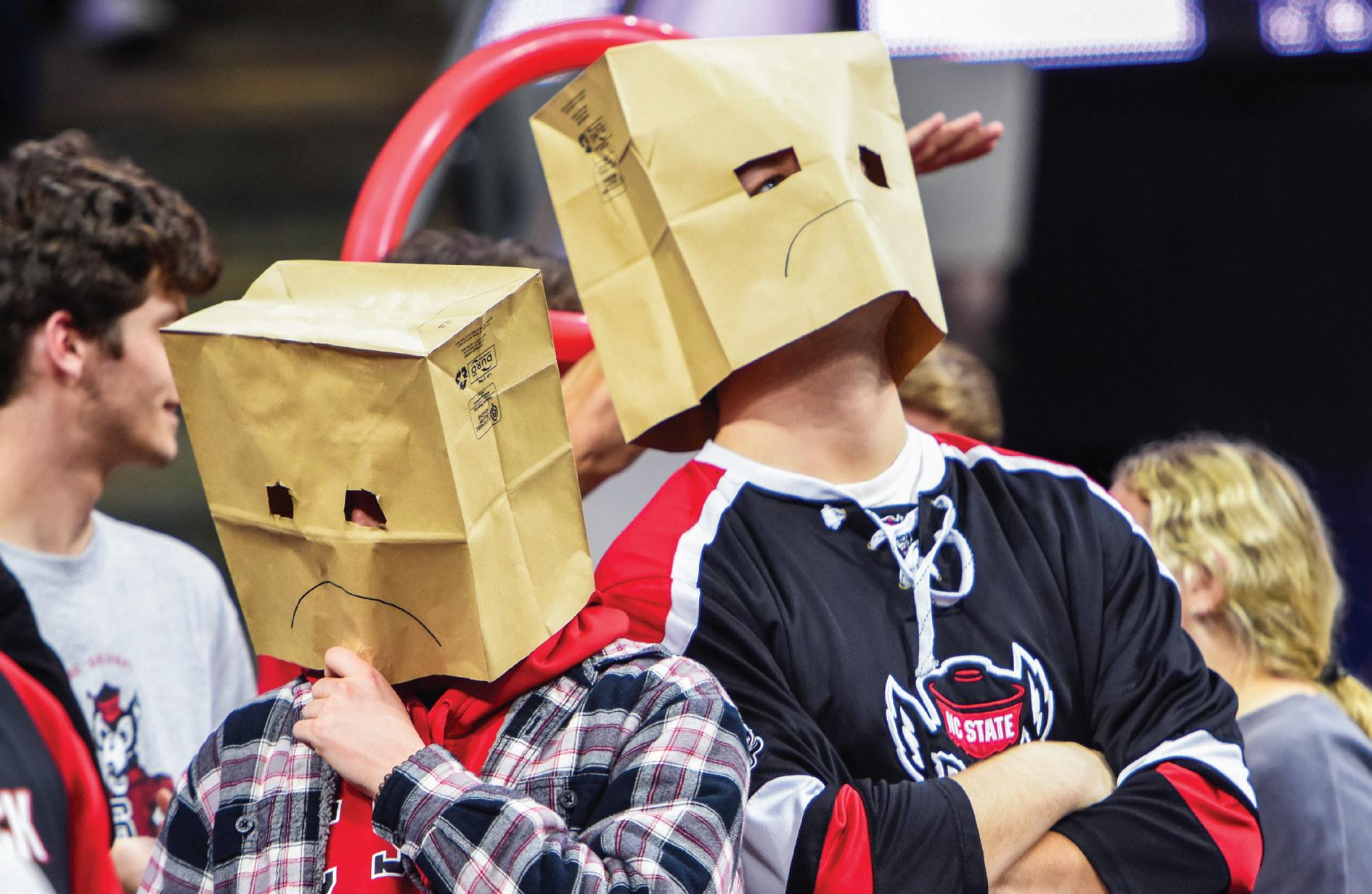
compilation on YouTube without realizing it. From threequarters-length down the court, Florida forward Chandler Parsons drilled a buzzer-beater to stun the Wolfpack fans inside then-PNC Arena.
The most gut-wrenching part is even if Parsons hit the shot from beyond half-court, the game could have gone to double overtime instead. With 2.6 seconds left on the clock, Pack guard Farnold Degand was sent to the line with NC State up one.
Making the first one, Degand rattled the second off the front of the rim and in less than three seconds, Parsons collected the rebound and swished the last-second heave. Had Degand made the second free throw, the game would’ve been tied and still given the Pack a chance to win in double overtime.
Women’s basketball 91-87 loss to UConn in Elite Eight
Hallie Walker, Class of 2024 and former Student Media photo editor: “[The game against] UConn when we were No. 1 but had to play UConn in Connecticut … broke my heart.”
Landon Hong, Class of 2025: “Robbed before the game even started, ended [a] special team that deserved a national championship.”
Less than a year removed from the NCAA expelling NC State baseball from the College World Series and NC State football’s bowl game being canceled — all due to Covid-related issues — the NCAA made another controversial decision. This time, it was aimed at NC State women’s basketball. Coming off the best year in program history with a 32-4 total record and a 13-1 ACC record, the women’s basketball team did more than enough to earn a one-seed in the tournament. Placed in the Bridgeport region, it was all well until the NCAA revealed that UConn was the No. 2 seed in the same region.
Located approximately 80 miles from UConn’s campus, the Bridgeport venue was essentially a home game for the Huskies, who at the time had made the women’s Final Four for
13-consecutive years.
Despite the adversity placed on the team before the game had even started, the Wolfpack still battled, but ultimately came up short. Wolfpack wing Jakia Brown-Turner’s 3-pointer sent the game to double overtime but guard Paige Bueckers and the Huskies proved to be too much to handle.
It’s always disappointing when a team loses that late in the tournament, but even more so when there are questions regarding whether the game was played at a neutral location that could’ve changed the outcome.
Men’s basketball 69-61 loss versus Georgetown in Sweet 16
Scott Greenough, Class of 1990: “The travel call against Corchiani killed our tourney.”
“Nowhere near a walk,” said CBS analyst Billy Packer. “Should have been a good basket and a foul. No steps at all. Not even close!”
Maybe the most infamous call in NC State sports was Corchiani’s “travel” against Georgetown in the 1989 regional semifinal. With less than two minutes to go against Georgetown, Wolfpack guard Chris Corchiani drove to the basket and laid it in, drawing a foul on the way.
Except, according to referee Rick Hartzell, he took too many steps.
Packer fervently disagreed and Hartzell apologized later for the call, but that didn’t stop NC State fans from holding their resentment back. Wolfpack head coach Jim Valvano never made it back to the NCAA Tournament, coaching just one more year before being ousted from the University under controversial circumstances.
Some argue that if the phantom call against Corchiani wasn’t called, it would have changed the course of the men’s basketball program. But if’s are like ghosts — they’re real depending on who you ask.
Editor
It’s time to call the Robert Anae experiment at NC State a massive failure.
The 65-year-old offensive coordinator is in the midst of his second season at NC State and the offense looks the most inconsistent it has in years. Anae was given the position after former Wolfpack offensive coordinator Tim Beck took the head coaching position at Coastal Carolina.
The hope was that the former Virginia offensive coordinator would continue his chemistry with then-incoming Virginia transfer quarterback Brennan Armstrong. Anae and Armstrong led an offensive unit that ranked third in the FBS in total offense in 2021. That 2021 Virginia squad was one of five programs in the FBS to average over 500 yards of total offense.
However, things went quite the opposite — Armstrong played so poorly that he was benched for then-sophomore quarterback MJ Morris. Armstrong eventually returned after MJ Morris redshirted and NC State finished the season with a 9-3 record thanks to its defense.
Nonetheless, NC State loaded up its offense with the most talent it had seen in years. Hyped up to be one of the top teams in the conference, the Wolfpack offense has floundered since week one and has quickly turned into one of the biggest liabilities on the team. Everyone is welcome to their own opinions on the condition of NC State’s offense under Anae. However, the numbers don’t lie. Here are some alarming statistics behind NC State’s offensive performance.
Sophomore wide receiver KC Concepcion won the 2023 ACC Rookie of the Year for a reason. He ranked 10th in the entire ACC in all-purpose yards as a freshman. 247 Sports ranked Concepcion as the eighth-best wide receiver in the nation before the season



started as most projected a huge sophomore season, due in large part to graduate quarterback Grayson McCall.
However, through his first eight games of the season, Concepcion has over 200 fewer yards than the first eight games of his freshman campaign, with 583 total yards in 2023 and just 378 total yards in 2024. Yes, McCall only played two full games, but Concepcion dealt with quarterback turmoil last year, so what is the difference-maker?
The answer is the playcalling. All too often, Concepcion has been the target of a screen multiple yards behind the line of scrimmage. It’s understandable to want to get the ball to your best target, but running screens over and over again is not the answer. You have to let your best weapon run downfield and do what he does best — create separation.
A key example is the Wake Forest game. Concepcion’s first three catches against Wake Forest went for an astonishing negative-six yards. The rest of the NC State receiving corps is talented, but using your star receiver as a dump-off pass is the last thing you want in an offense.
Concepcion hauled in nine catches for 121 yards and three touchdowns in the first game of the season but hasn’t come anywhere close to those numbers in the seven games since — he’s recorded over 50 yards just twice. The situation is so dire that junior tight end Justin Joly has 82 more receiving yards with 17 fewer catches. There is no excuse for Anae to continue to run multiple screen plays week after week when they clearly don’t work. Trust your players to make a play downfield, not behind the line of scrimmage.
Of the 17 teams in the ACC, Anae’s offense sits at just 14th in the conference, averaging 26 points per game. For an offense that’s faced an FCS team, three teams in the Group of Five and two belowaverage defenses in the ACC, there is shockingly little to show for it.
The offense was hyped up to be one of the best units in the conference, but sputtered out before the season fully began. The all-




graduate offensive line struggles to block on a consistent basis. The running back room is statistically one of the worst in the conference. McCall’s injury and subsequent retirement threw a wrench in the passing game.
However, the talent is still there. Fans have seen glimpses of freshman quarterback CJ Bailey’s potential. Concepcion and Joly need no introduction. Redshirt freshman running back Hollywood Smothers had a career game in California. All of the pieces necessary for a successful offense are there, but the scheme simply doesn’t work.
96th in the nation in third-down conversion rate
The Wolfpack has just a 35.71 third down conversion percentage in 2024. There are 68 schools in Power Four conferences, meaning that NC State’s third down conversion rate is so bad that it is outclassed by multiple Group of Five teams.
The Pack finds itself in third-and-long situations all too often as a result of the poor playcalling on earlier downs. Its third down playcalling is even worse. Multiple times, NC State has run a designated quarterback draw that almost never works. It seems as if the Pack is scared to open up the playbook. Redshirt junior punter Caden Noonkester is called on multiple times a game to bail the offense out when it inevitably goes three-and-out.
NC State’s confusing playcalling has killed it for two years. There is no reason for Concepcion to be lining up consistently in the backfield when young talent like Smothers and sophomore running back Kendrick Raphael have proven time and time again that they can get the job done. Another key example comes from the 2023 campaign when Anae had Armstrong line up as a running back on multiple occasions.
For a school that was hyped up to be an offensive juggernaut in the preseason, there are zero results. Talent is being wasted every year as NC State continues to slide down the ACC rankings. Something about the offense needs to change, and all signs point to one man.














KAMALA HARRIS CAST THE TIE-BREAKING VOTE TO PASS THE LARGEST INVESTMENT IN CLIMATE ACTION IN HISTORY.
- 37% IN GREENHOUSE GAS EMISSIONS + 1.5M NEW JOBS + $3,562 INCREASE IN REAL DISPOSABLE INCOME PER CAPITA
THE OTHER GUY SAID CLIMATE CHANGE IS A HOAX INVENTED BY CHINA.
ELECTION DAY: NOVEMBER 5
